Chapter Five
No Frills – Ausf J
Guderian knew that the German armed forces could not dispense with the Panzer IV. Upon taking up his post as Inspector-General of Armoured Troops he had assessed that ‘the production of the Panzer IV must be increased during the year 1944–45, so far as this can be done without damaging the production of Panthers and Tigers.’
The last model of the Mk IV had many features dropped during production in order to simplify and speed up construction. Notably one of the four return rollers was dispensed with as well as the pistol ports; some of the vision ports and the electric turret traverse plus the exhaust system were simplified. In the name of further expediency wire mesh screens were mounted on the sides of the hull instead of the normal Schürzen. It also had steel-tyred road wheels due to the shortage of rubber. Some 1,758 of this type were built from June 1944 to March 1945. The Ausf J saw combat in the battles for France, the Ardennes, the Rhineland and on the Eastern Front.
Ausf J
In light of problems refuelling and re-equipping in the field, German tank designers in their infinite wisdom decided to increase the Panzer IV’s range by 110km. For Operation Barbarossa, tanks, including the Panzer IV, had been furnished with a fieldmanufactured fuel trailer. This could carry two extra 200-litre petrol tanks. The 20-litre ‘Jerricans’ (or jerrycan) were also strapped to the turret. However, both measures were largely temporary fixes, especially as the trailers were easily damaged.
The designers boosted the 210km range of the Ausf G and H to 320km. This was achieved by increasing the 470-litre fuel capacity of the Ausf H to 680 litres. This came at a price because the extra space needed meant removing the auxiliary engine that powered the electric turret traverse on the Ausf J. On previous models this was positioned at the rear of the hull to the left of the large exhaust outlet. A dual gearratio hand traverse was installed instead. This was clearly a retrograde step and slowed firing response times. On late Ausf J the bulky engine silencer and exhaust outlet was replaced by two simple vertical exhaust mufflers.
There had been some hope of installing the Panther tank turret armed with the KwK42 L/70 gun on the Panzer IV chassis. The turret proved much too heavy and overloaded the chassis and transmission. Instead, the thickness of the turret roof armour on the Ausf J was increased and for close defence a Nähverteidigungswaffe smoke projector was fitted. This final model also used at least two different types of the modified East Tracks, which gave a better overall performance. As the name suggests these were developed as a result of battlefield experience on the Eastern Front.
In North Africa the Sherman had been able to hold its own against the early-model Panzer IVs, but in Normandy the frontal 80mm hull and superstructure armour of the Ausf H and J easily resisted its 75mm gun. Only the turret remained vulnerable. Limited numbers of Shermans were up-gunned with 17-pounder or 76mm guns but these were not up-armoured, leaving them at a real disadvantage.
The first Ausf J deployed to Normandy were fitted with standard Schürzen and coated in Zimmerit. While the hull Schürzen on the Ausf G and initial Ausf J consisted of six adjoining steel plates, on later production Ausf J they were replaced by simple wire mesh. These screens consisted of only three sections but covered the same area. Also by this stage the use of Zimmerit had been discontinued and it was not applied to the final batches of Ausf J. Both types of Schürzen were fitted to the Panzer IV/70 tank destroyer – photographic evidence shows a Panzer IV/70(A) with wire-mesh skirts.
By late 1943 production of the Panzer IV was increasingly under pressure. Although Guderian supported the factories being switched solely to the Panther, retooling would simply have been too disruptive. Panther manufacture was lagging behind and by this stage Germany was increasingly on the defensive on the Eastern Front. The result of this was that the Panzer IV was kept in production and was increasingly diverted to making assault guns and tank destroyers. This was exactly the same fate that had befallen the Panzer III.
In December 1943 Krupp-Gruson finally stopped building the Panzer IV gun tank and in the New Year switched production over to the StuG IV. Likewise in January 1944 Vomag began producing the Jagdpanzer IV alongside its Panzer IV. This continued until May when tank production was abandoned in favour of the Jagdpanzer IV and then the Panzer IV/70. In August 1944 Nibelungenwerke started building its own version of the Panzer IV/70. The result of this was that Nibelungenwerke was the only company to produce the Ausf J. As well as the 1,758 gun tanks, some 278 Ausf J chassis were diverted to Panzer IV/70 production from August 1944. Another 142 chassis were converted to Brummbärs.
Production was concentrated with Nibelungenwerke for a reason – the Allied bombing offensive. The original Panzer IV prototypes had been built by Krupp-Gruson at Magdeburg. Upon series production the Krupp factories in Essen and Eisen un Huettenwerke had built the hulls and turrets. Subcomponents had come from other companies. It was only with the Ausf F/G that production needed to be shared. At this point Vomag and Nibelungenwerke became involved. In the face of escalating Allied bombing of Germany’s industrial centres, the main production was then relocated to Nibelungenwerke which was out of range of the bombers.
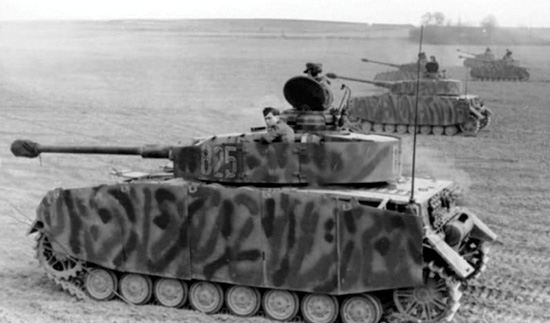
Panzer IV Ausf H on manoeuvres in France in 1944. They have a new type of drive sprocket and idler wheel. Also the turret is fitted with the new cupola with thicker armour and a single-piece cupola hatch. The haphazard three-tone camouflage has been sprayed on with little precision.
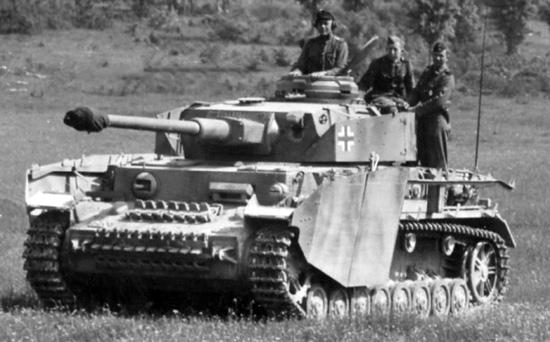
An Ausf J with the 2nd SS Panzer Division in France: half the nearside Schürzen is missing. This was added to afford some protection from the Soviet RPG-43 anti-tank grenade.

This late-production Ausf H lacks Zimmerit – this stopped being applied in September 1944 because it was time-consuming and due to unfounded fears it might be flammable. The tank has a very crudely painted three-tone camouflage scheme.

The Schürzen are intact on this Ausf J serving in Poland in 1944. The small front plate has a distinctive notch above the sprocket, designed to prevent snagging on the tracks.
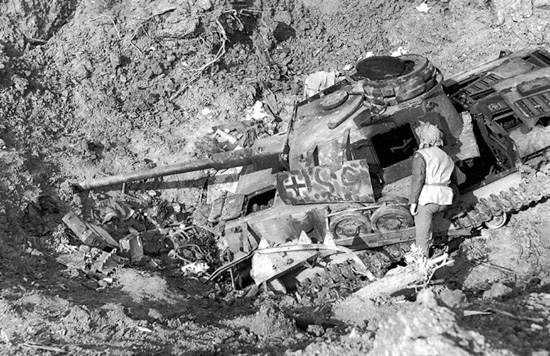
Remains of an Ausf J from the 26th Panzer Division, which fought in Italy in the Salerno and Cassino areas from January to May 1944. The hull has been shattered and the muzzle brake is clogged with dirt.
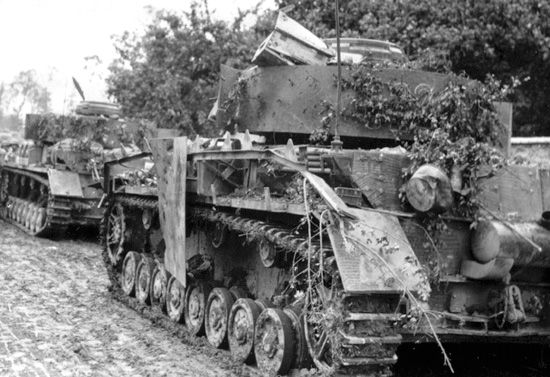
Two Ausf J belonging to the 2nd SS Panzer Division at St Fromond in Normandy in July 1944. Although the nearest tank has the standard engine muffler, the auxiliary engine for the electricpowered turret traverse is clearly missing.
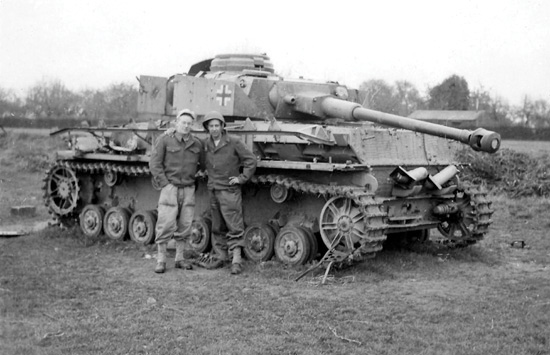
Photographed near Liège in Belgium, this Ausf J with its turret reversed has a simplified twin exhaust muffler. There is evidence of Zimmerit on the rear of the hull and the front of the turret, showing it was built before September 1944.
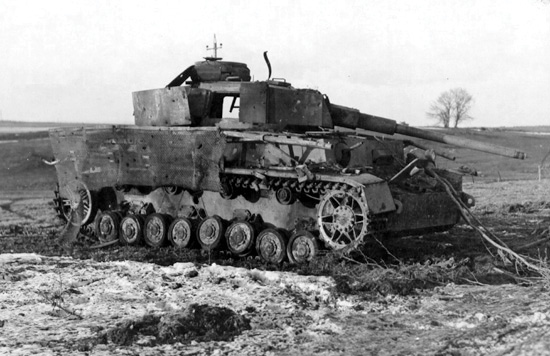
This burnt-out Ausf J pictured in January 1945 still has the remains of its mesh-screen Schürzen. This was from the early production run as it has four return rollers: on the later Js one roller was dropped.







